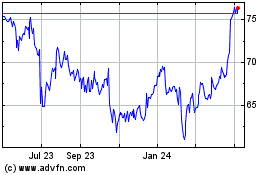FORM 6-K
SECURITIES
AND EXCHANGE COMMISSION
Washington,
D.C. 20549
Report
of Foreign Issuer
Pursuant
to Rule 13a-16 or 15d-16 of
the
Securities Exchange Act of 1934
For the
month of December 2022
Commission
File Number: 001-11960
AstraZeneca PLC
1
Francis Crick Avenue
Cambridge
Biomedical Campus
Cambridge
CB2 0AA
United
Kingdom
Indicate
by check mark whether the registrant files or will file annual
reports under cover of Form 20-F or Form 40-F.
Form
20-F X Form 40-F __
Indicate
by check mark if the registrant is submitting the Form 6-K in paper
as permitted by Regulation S-T Rule 101(b)(1):
Indicate
by check mark if the registrant is submitting the Form 6-K in paper
as permitted by Regulation S-T Rule 101(b)(7): ______
Indicate
by check mark whether the registrant by furnishing the information
contained in this Form is also thereby furnishing the information
to the Commission pursuant to Rule 12g3-2(b) under the Securities
Exchange Act of 1934.
Yes __
No X
If
“Yes” is marked, indicate below the file number
assigned to the Registrant in connection with Rule 12g3-2(b):
82-_____________
AstraZeneca PLC
INDEX
TO EXHIBITS
1.
Update on US review of Lynparza PROpel sNDA
15 December 2022 07:00 GMT
Update on US regulatory priority
review of Lynparza in combination with
abiraterone in metastatic castration-resistant prostate
cancer
AstraZeneca and MSD today announced that
the US Food and Drug Administration (FDA) has informed AstraZeneca
that it will extend the Prescription Drug User Fee Act (PDUFA)
date by three months to
provide further time for a full review of the supplementary new
drug application (sNDA) for Lynparza (olaparib)
in combination with abiraterone and prednisone or
prednisolone for the treatment
of metastatic
castration-resistant prostate cancer (mCRPC). The companies will
continue to work with the FDA to facilitate the completion of the
agency's review.
The sNDA is based on results from
the pivotal PROpel
Phase III trial, which
were published in June 2022 in NEJM
Evidence. In
August 2022, the sNDA was granted Priority
Review and
AstraZeneca and MSD are committed to working with the FDA to bring
this treatment option to patients with mCRPC.
In November,
the European Medicines Agency's Committee for Medicinal Products
for Human Use adopted a positive
opinion recommending
approval of Lynparza in
combination with abiraterone and prednisone or prednisolone in the
EU for the treatment of adult patients with mCRPC for
whom chemotherapy is not clinically indicated. This combination is
also undergoing regulatory reviews in other
countries.
Lynparza is
approved in the US based on results from the PROfound
Phase III trial as
monotherapy for patients with homologous recombination repair (HRR)
gene-mutated mCRPC (BRCA-mutated and other HRR gene
mutations) who
have progressed following prior treatment with enzalutamide or
abiraterone; and in the EU, Japan, and China for patients with
BRCA-mutated mCRPC who have progressed following prior therapy that
included a new hormonal agent.
Notes
Metastatic castration-resistant prostate cancer
Metastatic prostate cancer is associated with a significant
mortality rate.11 Development
of prostate cancer is often driven by male sex hormones called
androgens, including testosterone.12
In patients with mCRPC, their prostate cancer grows and spreads to
other parts of the body despite the use of androgen-deprivation
therapy to block the action of male sex
hormones.6 Approximately
10-20% of men with advanced prostate cancer will develop
castration-resistant prostate cancer (CRPC) within five years, and
at least 84% of these men will have metastases at the time of CRPC
diagnosis.6 Of
patients with no metastases at CRPC diagnosis, 33% are likely to
develop metastases within two years.5
Despite the advances in mCRPC treatment in the past decade with
taxane and new hormonal agent (NHA) treatment, there is high unmet
need in this population.6,8,9,13
PROpel
PROpel is a randomised, double-blind, multi-centre Phase
III trial testing the efficacy, safety, and tolerability
of Lynparza versus placebo when given in addition to
abiraterone in men with mCRPC who had not received prior
chemotherapy or NHAs in the mCRPC setting.
Men in both treatment groups also received either prednisone or
prednisolone twice daily. The primary endpoint is
investigator-assessed rPFS, with sensitivity analyses by BICR, and
secondary endpoints include overall survival, time to secondary
progression or death, time to first subsequent therapy, and quality
of life measures.
In the PROpel Phase III trial, Lynparza is combined with abiraterone, an NHA which
targets the androgen receptor (AR) pathway.
AR signalling engages a transcriptional programme that is critical
for tumour cell growth and survival in prostate
cancer.14,15 Preclinical
models have identified interactions between PARP signalling and the
AR pathway which support the observation of a combined anti-tumour
effect of Lynparza and NHAs, like abiraterone, in both HRR
deficient and HRR proficient prostate cancer.16-18
The PARP1 protein has been reported to be required for the
transcriptional activity of androgen receptors; therefore,
inhibiting PARP with Lynparza may impair the expression of androgen
receptor target genes and enhance the activity of
NHAs.14,17,19 Additionally,
it is thought that abiraterone may alter/inhibit the transcription
of some HRR genes which may induce HRR deficiency and increase
sensitivity to PARP inhibition.16,18,20,21
For more information about the trial please
visit ClinicalTrials.gov.
Lynparza
Lynparza (olaparib)
is a first-in-class PARP inhibitor and the first targeted treatment
to block DNA damage response (DDR) in cells/tumours harbouring a
deficiency in HRR, such as those with mutations in BRCA1 and/or
BRCA2, or those where deficiency is induced by other agents (such
as NHAs).
Inhibition of PARP with Lynparza leads to the trapping of PARP bound to DNA
single-strand breaks, stalling of replication forks, their collapse
and the generation of DNA double-strand breaks and cancer cell
death.
Lynparza is
currently approved in a number of countries across multiple tumour
types including maintenance treatment of platinum-sensitive
relapsed ovarian cancer and as both monotherapy and in combination
with bevacizumab for the 1st-line maintenance treatment of
BRCA-mutated (BRCAm) and homologous recombination repair deficient
(HRD)-positive advanced ovarian cancer, respectively; for gBRCAm,
HER2-negative metastatic breast cancer (in the EU and Japan this
includes locally advanced breast cancer); for gBRCAm, HER2-negative
high-risk early breast cancer (in Japan this includes all BRCAm
HER2-negative high-risk early breast cancer); for gBRCAm metastatic
pancreatic cancer; and HRR gene-mutated metastatic
castration-resistant prostate cancer (BRCAm only in the EU and
Japan). In
China, Lynparza is approved for the treatment of
BRCA-mutated metastatic castration-resistant prostate cancer as
well as a 1st-line maintenance therapy in BRCA-mutated advanced
ovarian cancer.
Lynparza, which
is being jointly developed and commercialised by AstraZeneca and
MSD, has been used to treat over 75,000 patients
worldwide. Lynparza has a broad clinical trial development
programme, and AstraZeneca and MSD are working together to
understand how it may affect multiple PARP-dependent tumours as a
monotherapy and in combination across multiple cancer
types. Lynparza is the foundation of AstraZeneca's
industry-leading portfolio of potential new medicines targeting DDR
mechanisms in cancer cells.
The AstraZeneca and MSD strategic oncology
collaboration
In July 2017, AstraZeneca and Merck & Co., Inc., Kenilworth,
NJ, US, known as MSD outside the US and Canada, announced a global
strategic oncology collaboration to co-develop and
co-commercialise Lynparza,
the world's first PARP inhibitor, and Koselugo (selumetinib),
a mitogen-activated protein kinase (MEK) inhibitor, for
multiple cancer types.
Working together, the companies will
develop Lynparza and Koselugo and
other potential new medicines as monotherapies and as combinations.
The companies will also develop Lynparza and Koselugo in
combination with their respective PD-L1 and PD-1 medicines
independently.
AstraZeneca in oncology
AstraZeneca is leading a revolution in oncology with the ambition
to provide cures for cancer in every form, following the science to
understand cancer and all its complexities to discover, develop and
deliver life-changing medicines to patients.
The Company's focus is on some of the most challenging cancers. It
is through persistent innovation that AstraZeneca has built one of
the most diverse portfolios and pipelines in the industry, with the
potential to catalyse changes in the practice of medicine and
transform the patient experience.
AstraZeneca has the vision to redefine cancer care and, one day,
eliminate cancer as a cause of death.
AstraZeneca
AstraZeneca (LSE/STO/Nasdaq: AZN) is a global, science-led
biopharmaceutical company that focuses on the discovery,
development, and commercialisation of prescription medicines in
Oncology, Rare Diseases, and BioPharmaceuticals, including
Cardiovascular, Renal & Metabolism, and Respiratory &
Immunology. Based in Cambridge, UK, AstraZeneca operates in over
100 countries and its innovative medicines are used by millions of
patients worldwide. Please visit astrazeneca.com and
follow the Company on Twitter @AstraZeneca.
Contacts
For details on how to contact the Investor Relations Team, please
click here.
For Media contacts, click here.
References
1. Cancer.org. Key Statistics for
Prostate Cancer. Available at https://www.cancer.org/cancer/prostate%20cancer/about/key-statistics.html.
Accessed December 2022.
2. Ng K, et al. Metastatic Hormone-Sensitive Prostate Cancer
(mHSPC): Advances and Treatment Strategies in the First-Line
Setting. Oncol Ther. 2020; 8:209-230.
3. Shore N, et al. Real-World Treatment Patterns and Overall
Survival of Patients with Metastatic Castration-Resistant Prostate
Cancer in the US Prior to PARP Inhibitors. Adv Ther. 2021;38:4520-4540.
4. Wallis C, et al. Real-World Use of Androgen-Deprivation Therapy:
Intensification Among Older Canadian Men With de Novo Metastatic
Prostate Cancer. JNCI Cancer
Spectr. 2021;5(6):pkab082.
5. George D, et al. Treatment Patterns and Outcomes in Patients With
Metastatic Castration-resistant Prostate Cancer in a Real-world
Clinical Practice Setting in the United
States. Clin Genitourin
Cancer. 2020
Aug;18(4):284-294.
6. Kirby, M, et al. Characterising the Castration-Resistant Prostate
Cancer Population: a Systematic Review. Int J of Clin
Pract.
2021;65(11):1180-1192.
7. Smith MR, et al. Natural History of Rising Serum
Prostate-Specific Antigen in Men with Castrate Nonmetastatic
Prostate Cancer. J Clin
Oncol.
2005;23(13):2918-25.
8. UroToday. What is
Changing in Advanced Prostate Cancer? Available
at https://www.urotoday.com/journal/everyday-urology-oncology-insights/articles/122176-what-is-changing-in-advanced-prostate-cancer.html.
Accessed December 2022.
9. Liu
J, et
al. Second-line Hormonal
Therapy for the Management of Metastatic Castration-resistant
Prostate Cancer: a Real-World Data Study Using a Claims
Database. Sci Rep. 2020;10(1):4240.
10. Mateo J, et al. DNA-Repair Defects and Olaparib in Metastatic
Prostate Cancer. N Engl J
Med. 2015;373:1697-1708.
11. Chowdhury
S, et
al. Real-World Outcomes in
First-Line Treatment of Metastatic Castration-Resistant Prostate
Cancer: The Prostate Cancer Registry. Target
Oncol.
2020;15(3):301-315.
12. Cancer.Net.
Prostate Cancer: Types of Treatment. Available
at https://www.cancer.net/cancer-types/prostate-cancer/types-treatment.
Accessed December 2022.
13. UroToday. Beyond
First-line Treatment of Metastatic Castrate-resistant Prostate
Cancer. Available at https://www.urotoday.com/library-resources/mcrpc-treatment/114592-beyond-first-line
treatment-of-metastatic-castrate-resistant-prostate-cancer.html.
Accessed December 2022
14. Schiewer
MJ, et
al. Dual Roles of PARP-1
Promote Cancer Growth and Progression. Cancer
Discov. 2012;2(12):1134-1149.
15. Schiewer MJ & Knudsen KE.
AMPed up to treat prostate cancer: novel AMPK activators emerge for
cancer therapy. EMBO Mol
Med.
2014;6(4):439-441.
16. Li L, et al. Androgen Receptor Inhibitor-Induced
"BRCAness" and PARP Inhibition are Synthetically Lethal for
Castration-Resistant Prostate Cancer. Sci Signal. 2017; 10(480):eaam7479.
17. Polkinghorn
WR, et
al. Androgen Receptor Signaling
Regulates DNA Repair in Prostate Cancers. Cancer
Discov. 2013;3(11):1245-1253.
18. Asim M, et al. Synthetic Lethality Between Androgen Receptor
Signalling and the PARP Pathway in Prostate
Cancer. Nat Commun. 2017;8(1):374.
19. Ju B-G, et al. A Topoisomerase IIbeta-Mediated dsDNA Break
Required for Regulated Transcription. Science. 2006;312(5781):1798-1802.
20. Goodwin
JF, et
al. A Hormone-DNA Repair
Circuit Governs the Response to Genotoxic
Insult. Cancer
Discov.
2013;3(11):1254-1271.
21. Tarish
FL, et
al. Castration Radiosensitizes
Prostate Cancer Tissue by Impairing DNA Double-Strand Break
Repair. Sci Transl
Med.
2015;7(312):312re11.
Adrian Kemp
Company Secretary
AstraZeneca PLC
SIGNATURES
Pursuant
to the requirements of the Securities Exchange Act of 1934, the
Registrant has duly caused this report to be signed on its behalf
by the undersigned, thereunto duly authorized.
Date:
15 December 2022
|
|
By: /s/
Adrian Kemp
|
|
|
Name:
Adrian Kemp
|
|
|
Title:
Company Secretary
|
AstraZeneca (NASDAQ:AZN)
Historical Stock Chart
From Mar 2024 to Apr 2024

AstraZeneca (NASDAQ:AZN)
Historical Stock Chart
From Apr 2023 to Apr 2024
